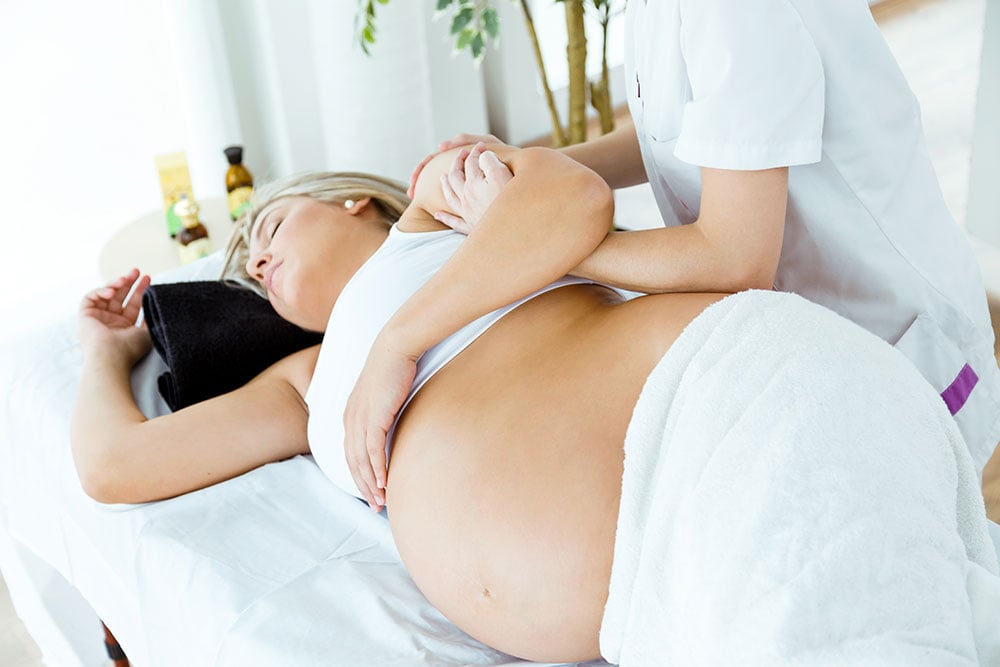Prenatal Massage: What’s Safe and What You Should Avoid

Massage is a relaxing experience, but it also boasts some important health benefits. While pregnancy is an entirely natural process, it also causes changes in the body that lead to temporary discomfort. Also, add in juggling high-stress careers and families, massage therapy is the perfect way to get some alone time and pampering.
Since pregnant women are limited in the way they can safely and effectively relieve their discomfort and stress during pregnancy, they often turn to prenatal massage therapy. The good news is getting a massage while pregnant from a licensed massotherapist is one of the most highly effective ways to manage aches and pains.
Massage therapy consists of several different techniques, including:
- Swedish Massage
- Deep Tissue Massage
- Chair Massage
- Stone Massage
Let's take a look at each of these ways to de-stress with massage:
-
Swedish Massage (Approved for Pregnant Women). Swedish massage is also known as the classic massage. It involves five kinds of touch and is delivered to the soft tissues using the therapist’s hands, moisturized with massage oil or lotion. Through kneading, rolling, vibration tapping, and percussive movements, your blood will begin to circulate better. This sends more oxygen to your muscles and helps them relax. During pregnancy, a massage therapist will have the pregnant woman lie on her side. This is safe to do during pregnancy with a licensed massage therapist.
-
Deep Tissue Massage (Approved for Pregnant Women). Many women are concerned about getting a deep tissue massage during pregnancy for fear of harming the baby. There are indeed areas to avoid. However, pregnant women can significantly benefit from a deep tissue massage from a licensed massage therapist.
Deep tissue massage uses many traditional massage techniques but takes it one step further, getting into the deep tissue areas of your body. Once the skin and muscles are relaxed using classic massage, the therapist goes deeper into the tissues that join your body parts together, the underlying musculature and connective tissue called fascia. Deep tissue massage is also an excellent remedy for chronic muscular pain, injury rehabilitation, and pain reduction caused by arthritis and tendonitis.
-
Chair Massage (Approved for Pregnant Women). Chair massage has become a popular way to de-stress while shopping in a mall or traveling by air, and it’s perfectly safe for pregnant women.
A chair massage therapist doesn't use oil or lotion, and you're fully clothed during the massage. In addition, the sessions are shorter than traditional massage, usually 20 minutes or less. Chair massage focuses pressure only on the head, neck, shoulders, back, and arms. Also, the cost is easy on your wallet, too, usually costing approximately $1 a minute.
-
Stone Massage (Not Approved for Pregnant Women). You've probably seen pictures in magazines or on the web of people receiving a stone massage. Smooth, heated, black stones are placed along a person's spine and used as an extension of the therapist's hand in conjunction with a traditional massage.
A hot stone massage is not recommended for women beyond their first trimester of pregnancy. During this type of massage, the woman is to lie on her back or stomach, which could cause harm to the baby.
Benefits of Massage
Besides having some alone time and pampering, there are several benefits of massage, including:
-
Stress and Anxiety Reduction. Massage therapy can reduce stress both mentally and physically. Reducing anxiety and decreasing symptoms of depression alongside relieving muscle and joint aches can also improve labor outcomes and newborn health.
-
Reduction of Swelling/Oedema. Swelling during pregnancy is the body’s normal response to increased pressure on the major blood vessels and reduced blood circulation. Stimulating the soft tissue helps to reduce the collection of fluids in the joints and improves waste removal by the lymph system.
-
Hormone Regulation. Massage therapy can significantly decrease hormone levels resulting in improved cardiovascular health and mood regulation.
-
Nerve Pain Improvement. During the final trimester, pressure from the heavy uterus resting on the lower back and pelvic floor can cause swelling and pressure on nearby nerves. Sciatic nerve pain can become a common experience for many women during this later stage. By relieving the stress on these muscles, massage therapy can alleviate the pressure on the nerves and thus have a significant reduction in sciatic nerve pain.
Before making an appointment for a massage, speak with your OB-GYN. This will help ensure your safety and make sure your massage a rewarding one.


